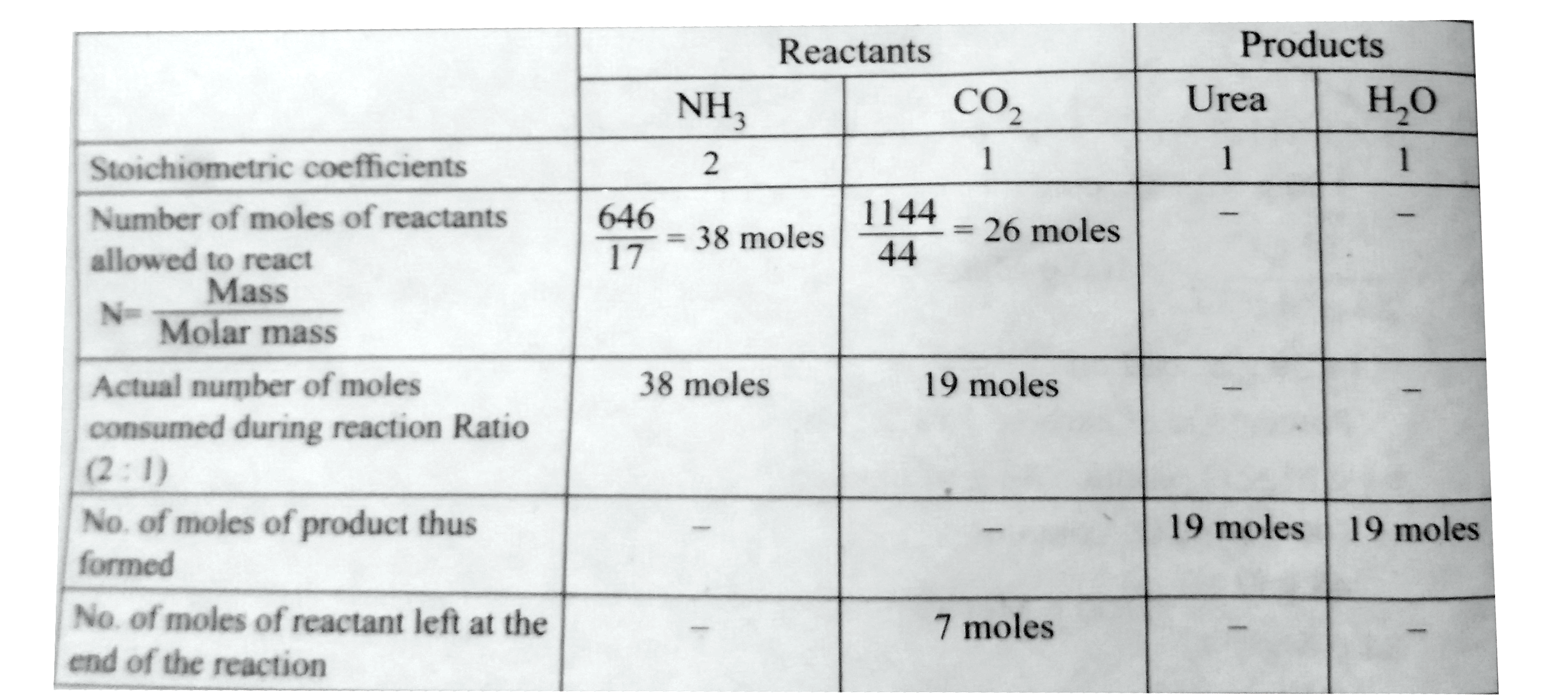In a process, 646 g of ammonia is allowed to react with 1.144 kg of CO2 to form urea.
(i) If the entire quantity of all the reactants is not consumed in the reaction which is the limiting reagent ?
(ii) Calculate the quantity of urea formed and unreacted quantity of the excess reagent. The balanced equation is
2NH3+CO2H2NCONH2+H2OSolution in Tamil
(i) The entire quantity of ammonia is consumed in the reaction. So ammonia is the limiting reagent. Som,e quantity of CO2 remains unreacted, so CO2 is the excess reagent.
(ii) Quantity of urea formed = number of moles of urea formed x molar mass of urea = 19 moles ×60gmol−1
= 1140 g = 1.14kg
Excess reagent leftover at the end of the reaction is carbon dioxide. Amount of carbon dioxide leftover = number of moles of CO, left over x molar mass of CO2 = 7moles×44gmol−1 = 308 g.

Topper's Solved these Questions
- BOOK - FULL MARKSCHAPTER - BASIC CONCEPTS OF CHEMISTRY AND CHEMICAL CALCULATIONS EXERCISE - Additional Questions Solved(Choose the correct)33videos
BASIC CONCEPTS OF CHEMISTRY AND CHEMICAL CALCULATIONS
- BOOK - FULL MARKSCHAPTER - BASIC CONCEPTS OF CHEMISTRY AND CHEMICAL CALCULATIONS EXERCISE - Additional Questions Solved(Match the following)3videos
BASIC CONCEPTS OF CHEMISTRY AND CHEMICAL CALCULATIONS
- BOOK - FULL MARKSCHAPTER - BASIC CONCEPTS OF CHEMISTRY AND CHEMICAL CALCULATIONS EXERCISE - In Text Questions - Evaluate Yourself8videos
BASIC CONCEPTS OF CHEMISTRY AND CHEMICAL CALCULATIONS
- BOOK - FULL MARKSCHAPTER - ALKALI AND ALKALINE EARTH METALSEXERCISE - Additional Questions Solved224videos
ALKALI AND ALKALINE EARTH METALS
- BOOK - FULL MARKSCHAPTER - BASIC CONCEPTS OF ORGANIC REACTIONS EXERCISE - Additional Questions Solved (5-Marks Question)10videos
BASIC CONCEPTS OF ORGANIC REACTIONS
Similar Questions
Which one among the following is the standard for atomic mass?
09:24View SolutionMatch the List-I and List-II using the correct code given below the list.
 05:18View Solution
05:18View SolutionBy applying the knowledge of chemical classification, classify each of the following into elements, compounds or mixtures
(i) Sugar
(ii) Sea water
(iii) Distilled water
(iv) Carbon dioxide
(v) Copper wire
(vi) Table salt
(vii) Silver plate
(viii) Naphthalene balls02:28View SolutionWhy alkali metals and alkaline earth metals are called s-block elements?
04:57View SolutionExplain electron movement in organic reactions.
05:18View Solution50g of CaCO3 is allowed to react with 70g of H3PO4. Calculate :
(i) amount of Ca3(PO4)2 formed
(ii) amount of unreacted reagent02:43View SolutionThe reactant which is entirely consumed in reaction is known as limiting reagent. In the reaction 2A+4B→3C+4D, when 5 moles of A react with 6 moles of B, then
(a) which is the limiting reagent?
(b) calculate the amount of C formed?View Solutionकिसके रुधिर में यूरिया की मात्रा सर्वांधिक होगी?
View Solution3.0 g of H_(2) react with 29.0 g of O_(2) to form H_(2)O . (i) which is the limiting reagent? (ii) Calculate the maximum amount of H_(2)O that can be formed. (iii) Calculate the amount of the reactant left unreacted. Molecular mass of H_(2)=2.016 .
04:57View SolutionThe reactant which is entirely consumed in reaction is known as limiting reagent. In the reaction 2A+4B→3C+4D, when 5 moles of A react with 6 moles of B, then
(a) which is the limiting reagent?
(b) calculate the amount of C formed?07:31View SolutionThe reactant which is entirely consumed in any reaction is known as the limiting reagent. In the reaction, 2A+4B to 3C+4D , if 5 moles of A react with 6 moles of B, then (1) Which is the limiting reagent? (2) Calculate the amount of C formed.
04:45View SolutionThe reactant which is entirely consumend in reaction is known as limiting reagent. In the reaction 2A+4B→3C+4D , when 5 moles of A react with 6 moles of B , then
(i) Which is the limiting reagent
(ii) Calculate the amount of C formed.03:54View Solution6 g of H_(2) reacts with 14 g N_(2) to form NH_(3) till the reaction completely consumes the limiting reagent. The mass of other reactant (in g) left are ……
View Solution3.0 g of H_(2) react with 29.0 g of O_(2) yield H_(2)O . (i) Which is the limiting reagent. (ii) Calculate the maximum amount of H_(2)O that can be formed (iii) Calculate the amount of reactant left unreacted
04:53View Solution3.0 g of H_(2) react with 30.0 g of O_(2) yield H_(2)O . (i) Which is the limiting reagent? (ii) Calculate the maximum amount of H_(2)O that can be formed. (iii) Calculate the amount of reactant left unreacted.
02:21View Solution

